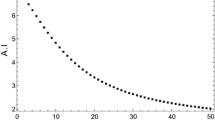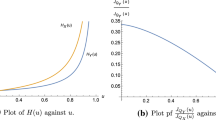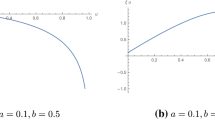Abstract
This paper deals with the simple additive degradation models with single random effect. The authors further study the link between the aging property of the implied lifetime and that of the random variation. It is found that both the aging property of the random variation and the analytical behavior of the mean degradation path influence the aging behavior of the implied lifetime.
Similar content being viewed by others
References
C. J. Lu and W. Q. Meeker, Using degradation measures to estimate of time to failure distribution, Technometrics, 1993, 35: 161–176.
S. J. Bae and P. H. Kvam, A nonlinear random coefficients model for degradation testing, Technometrics, 2004, 46: 460–469.
S. J. Bae, W. Kuo, and P. H. Kvam, Degradation models and implied lifetime distributions, Reliability Engineering and System Safety, 2007, 92: 601–608.
H. W. Block and T. H. Savits, The reversed hazard rate function, Probability in the Engineering and Informational Sciences, 1998, 12: 69–70.
N. K. Chandra and D. Roy, Some results on reversed hazard rate, Probability in the Engineering and Informational Sciences, 2001, 15: 95–102.
F. S. Finkelstein, On the reversed hazard rate, Reliability Engineering and System Safety, 2002, 78: 71–75.
X. Li and J. Lu, Stochastic comparisons on residual life and inactivity time of series and parallel systems, Probability in Engineering and Informational Sciences, 2003, 17: 267–275.
X. Li and Ming J. Zuo, Stochastic comparison on residual life and inactivity time at random time with applications, Stochastic Models, 2004, 20: 229–235.
R. E. Barlow and F. Proschan, Statistical Theory of Reliability and Life Testing, To Begin with, Silver Springer: MD., 1981.
M. Shaked and J. G. Shanthikumar, Stochastic Orders and Their Applications, Academic Press, San Diego, 1994.
M. Bagnoli and T. Bergstrom, Log-concave probability and its applications, Economic Theory, 2005, 26: 445–469.
A. Müller and D. Stoyan, Comparison Methods for Stochastic Models and Risks, John Wiley & Sons, New York, 2002.
Author information
Authors and Affiliations
Corresponding author
Additional information
This research is supported by National Natural Science Foundation of China under Grant No. 10771090.
This paper was recommended for publication by Editor Guohua ZOU.
Rights and permissions
About this article
Cite this article
Li, X., Yan, R. & Zhao, Y. Aging properties of the lifetime in simple additive degradation models. J Syst Sci Complex 24, 753–760 (2011). https://doi.org/10.1007/s11424-011-8240-z
Received:
Revised:
Published:
Issue Date:
DOI: https://doi.org/10.1007/s11424-011-8240-z




